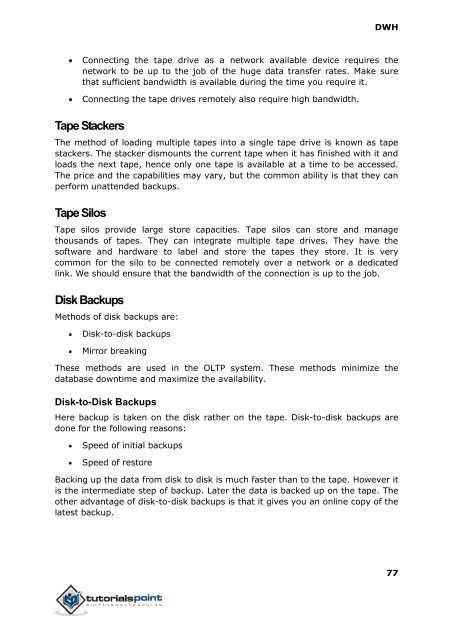dwh_tutorial
Create successful ePaper yourself
Turn your PDF publications into a flip-book with our unique Google optimized e-Paper software.
DWH<br />
<br />
<br />
Connecting the tape drive as a network available device requires the<br />
network to be up to the job of the huge data transfer rates. Make sure<br />
that sufficient bandwidth is available during the time you require it.<br />
Connecting the tape drives remotely also require high bandwidth.<br />
Tape Stackers<br />
The method of loading multiple tapes into a single tape drive is known as tape<br />
stackers. The stacker dismounts the current tape when it has finished with it and<br />
loads the next tape, hence only one tape is available at a time to be accessed.<br />
The price and the capabilities may vary, but the common ability is that they can<br />
perform unattended backups.<br />
Tape Silos<br />
Tape silos provide large store capacities. Tape silos can store and manage<br />
thousands of tapes. They can integrate multiple tape drives. They have the<br />
software and hardware to label and store the tapes they store. It is very<br />
common for the silo to be connected remotely over a network or a dedicated<br />
link. We should ensure that the bandwidth of the connection is up to the job.<br />
Disk Backups<br />
Methods of disk backups are:<br />
<br />
<br />
Disk-to-disk backups<br />
Mirror breaking<br />
These methods are used in the OLTP system. These methods minimize the<br />
database downtime and maximize the availability.<br />
Disk-to-Disk Backups<br />
Here backup is taken on the disk rather on the tape. Disk-to-disk backups are<br />
done for the following reasons:<br />
<br />
<br />
Speed of initial backups<br />
Speed of restore<br />
Backing up the data from disk to disk is much faster than to the tape. However it<br />
is the intermediate step of backup. Later the data is backed up on the tape. The<br />
other advantage of disk-to-disk backups is that it gives you an online copy of the<br />
latest backup.<br />
77


